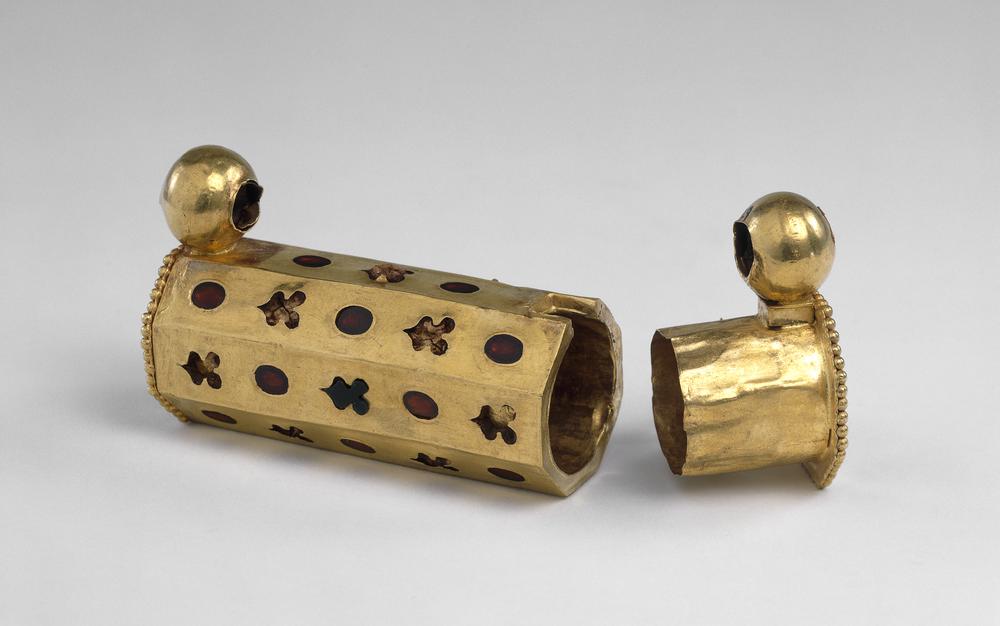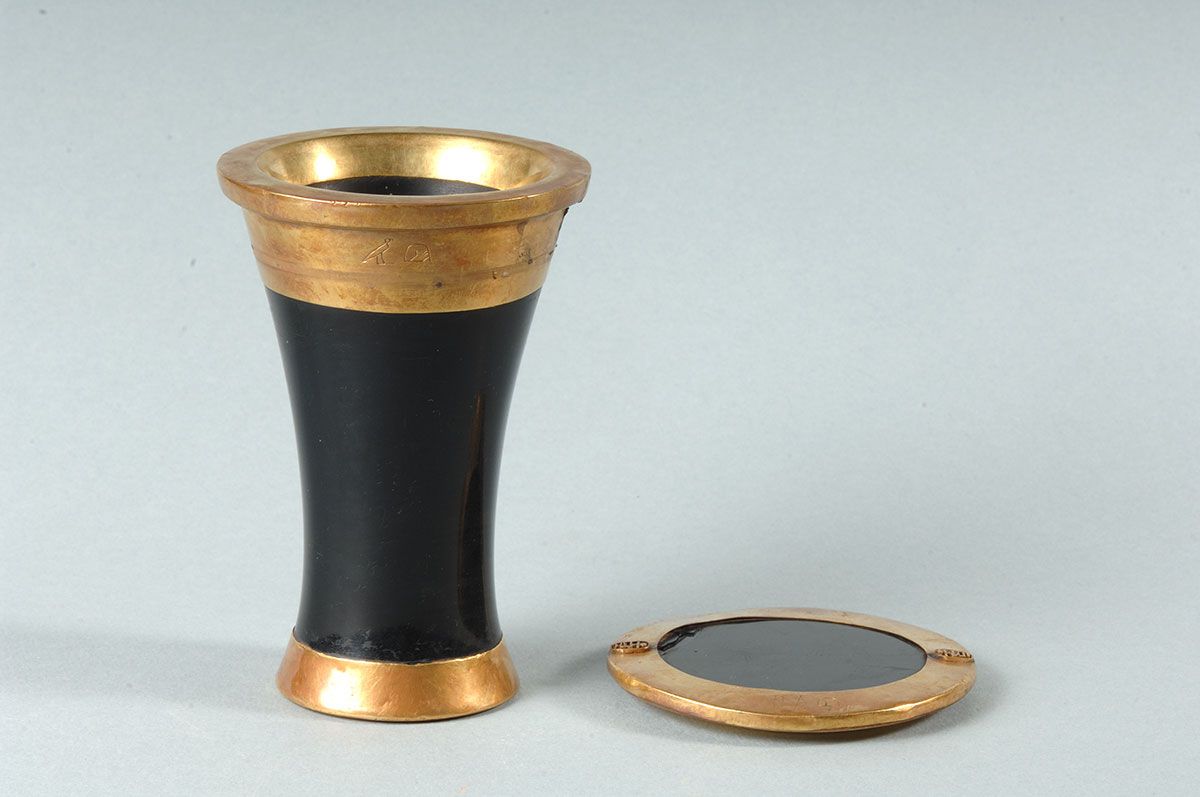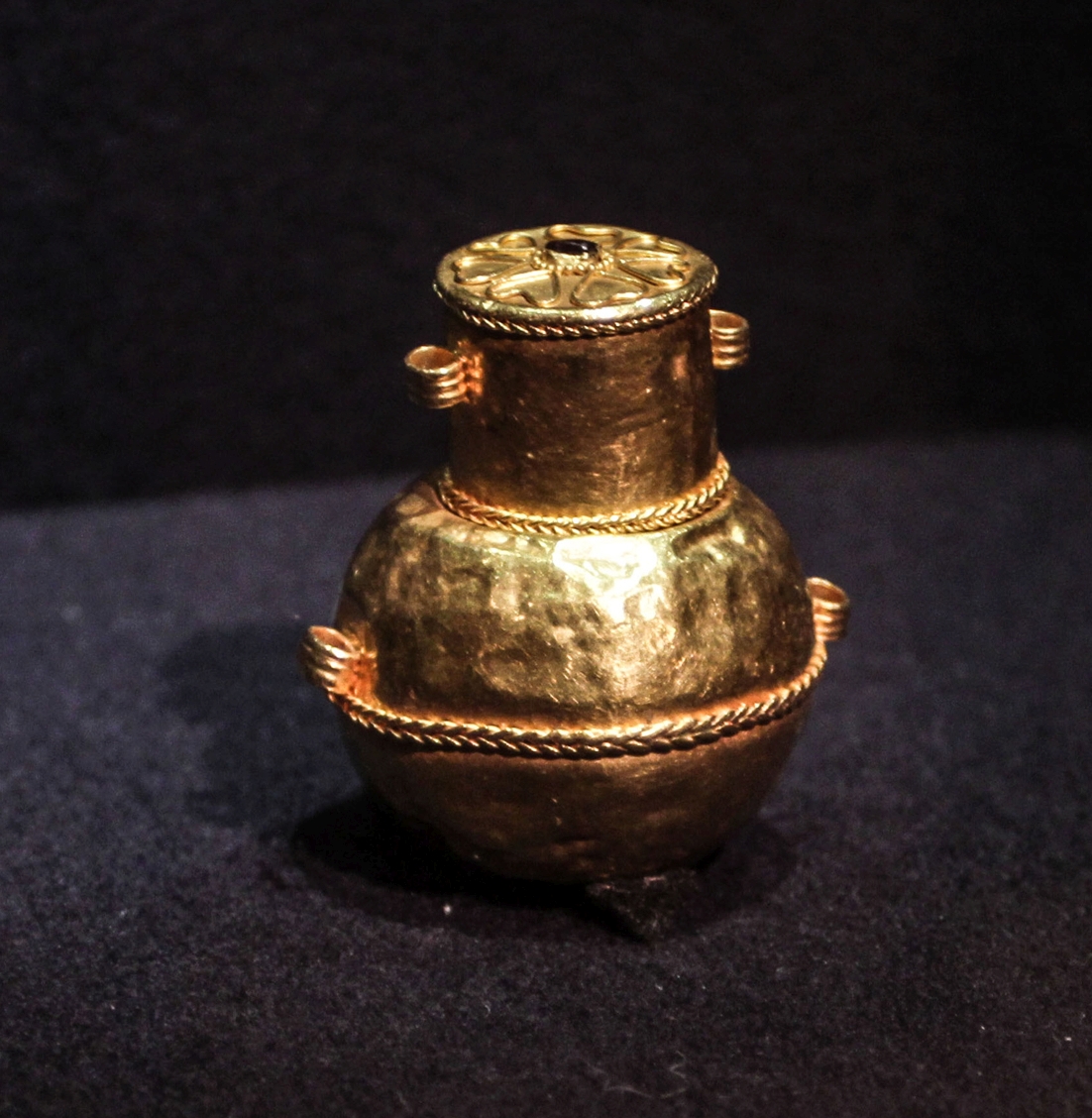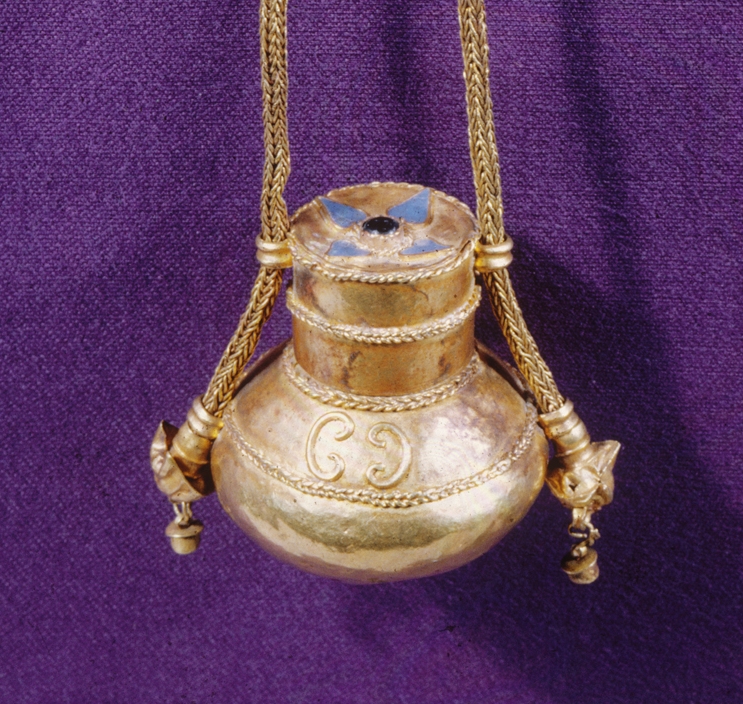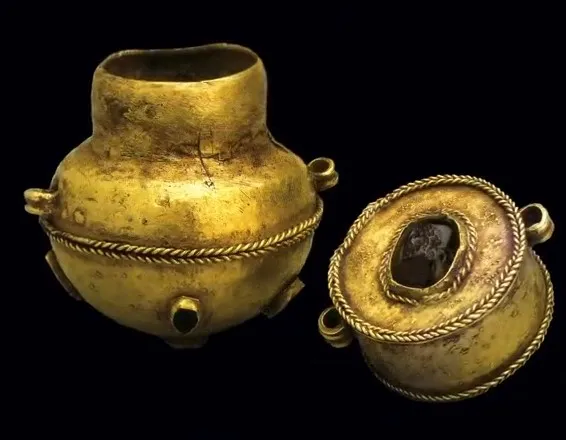Hellenistic jewelry
“Most of the artifacts that are part of this collection are from the locality of Isar-Marvinci, Valandovo. This site together with the ancient Lychnid (Ohrid) represent the best explored sites from this period in Macedonia. In the collection, the artifacts discovered at the Vardarski Rid site, the Pelagonian, Tikvesh, Skopje and Povardaria regions stand out.” [Museum website >> https://amm.org.mk/helenistichki-period]
The gold archaeological artifacts from the 4th and 3rd centuries BCE were found at the archaeological site “Ormankov Grob” [„Орманков гроб“], Tremnik village, Negotino Municipality.
“Archaeologists assume that the tomb belonged to a distinguished soldier-officer originally from Antigonea, who must have been in the army of Alexander the Great while he was fighting in Asia, and upon his return he brought all this gold jewelry, with which he was then buried. The artifacts are today in the Archaeological Museum of Macedonia.” [an article Photos of the gold artifacts from Tremnik in Kumanovo]
“In August 2008, during an archaeological investigation by a team of experts from the Museum of the City of Negotino, under the direction of curator-adviser archaeologist Kire Angelovski, at a depth of 0.35 to 0.50 cm, several objects of gold jewelry and coins were found, dated from the 4th-3rd century BCE, namely:
– 2 (two) coin-staters with the image of Philip II and Alexander III,
– 4 (four) fibulae of the Asia Minor type with five star-shaped decorative outlets on the arches, legs with massive stylized snake heads and heads in the form of palm leaves. W 9.3 cm, H 6 cm, weight 141.4 g,
– 31 samples of gold pendants in the shape of a spear,
– 32 samples of gold pendants in the form of hazelnut,
– 484 small rings decorated with granules,
– 84 small rings with three rows of granules,
– 2 (two) golden endings of a necklace in the form of palmettes,
– 4 (four) gold cylindrical necklace tubes decorated with filigree and granulation,
– 1 (one) small two-part box (pyxis) made of gold in a cylindrical shape richly decorated with filigree and granulation. H 2.5 cm, W 3 cm, weight 27.9 g
– 1 (one) decorative relief plaque-medallion with a representation of Poseidon holding a trident in his left hand, flanked to the left and right by protomes of two horses.
The total weight of these items is about 1 kg rich with 22% carat gold. It is supposed to have belonged to a distinguished soldier-officer originally from Paion of Antigonea, who must have been in the army of Alexander the Great while he was at war in Asia, and on his return brought all this gold jewelry, with which he was afterwards buried.” [Изложба на фотографии „Златниот антички наод од Неготинско“ во Центарот за култура „Трајко Прокопиев“ – Куманово https://makfax.com.mk/kultura]



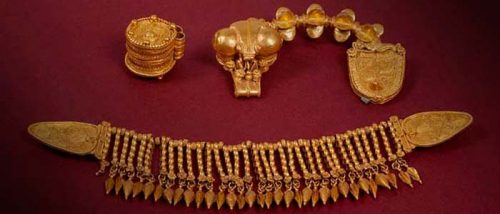







“Golden fibula of the Macedonian (Asia Minor) type, 4th century BC, Ormankov grave site near the village. Tremnik-Negotino. The Macedonian or Asia Minor type of fibulae are so called because of their origin from Asia Minor or more precisely from Phrygia (a country closely related to the Macedonian Brigs), but they make their stylistic development strictly in Macedonia in the IV-III centuries before Christ. The main characteristics of these fibulae are the unusual shape of the head and foot. The head is connected to the needle with the help of beautifully made screws, usually with the shape of a palm tree in different variants, more or less recognizable. They have five or six decorations on the bow. Parallel to this decoration, one can also notice the decorative element of a snake’s head on the leg of the fibula, which is even stylized. It comes as a reflection of the “snake style” present in the Macedonian-Paeonian and Epirus area in the Archaic and Classical times.”

To compare
Gold fibulas in the Met Accession Number: 37.11.8–.17
Greek, Hellenistic 330–300 BCE, said to be from Thessaloniki area. The two pairs of gold fibulae are described as of Macedonian-type.

Pair of silver fibulas from a hoard discovered in 1964 in the village of Vladinya, Lovech region, Bulgaria.
Second half of 4th century BCE.
height: 6.6 cm; length: 8 cm, weight: 71-72 g
“Hinged (Scharnier) fibula. Arched bow decorated with six solid profiled rings at uniform intervals. The head-plate is 3.7 cm long and 3.2 cm wide, cut flat at the top, shaped as a stylized palmette, engraved and decorated with granules.
The base of the pin is visible. The catch-plate is shaped as bucranium, decorated with two hemispheres, a plate with stamped circles and a rosette outlined by incised lines and granules.”

M. Tonkova, T. Stoyanov

Belt buckle with a representation of the sea god Poseidon, dated to the end of the 4th century BCE.
Димензии: ширина: 8 cm, висина: 7 cm, тежина: 69 gr.
“On this belt buckle, which is made of gold using a casting technique, Poseidon is depicted holding a trident in his left hand and riding two sea horses known in Greek mythology as Hippocampi (monsters).”
Source: Museum’ FB https://www.facebook.com/

“Golden staters of Philip II and Alexander III of Macedonia, second half of the IV century BC, found at the Ormankov grave site near the village. Tremnik-Negotino. The staters together with other 22-carat gold jewelry with a total weight of about 1 kilogram were found in 2008 as a buried depot that may have belonged to an officer who participated in the campaigns of Alexander the Great or to a Paion aristocrat. The depot was buried during the invasion of the Celts in 279-277 BC. They are kept in the Archaeological Museum of the Republic of Macedonia.”

- Ormankov Grob https://mk.wikipedia.org/wiki
- АРХЕОЛОШКО ОДДЕЛЕНИЕ http://www.muzejnegotino.mk/Arheo.aspx?id=1
- Macedonian Archaeology FB https://www.facebook.com
- Museum’ FB https://www.facebook.com/
- an article Photos of the gold artifacts from Tremnik in Kumanovo
- Изложба на фотографии „Златниот антички наод од Неготинско“ во Центарот за култура „Трајко Прокопиев“ – Куманово https://makfax.com.mk/kultura


